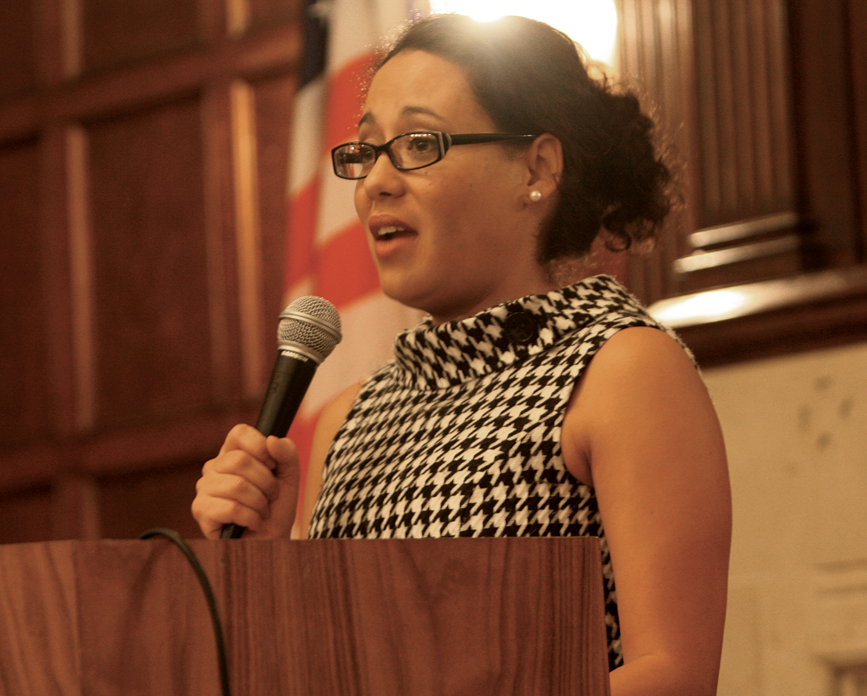
Mira Ramos, a speaker at the RU Ready event in Copley Formal Lounge Wednesday, addresses sexual violence.
When Mia Ramos, a survivor of sexual assault, spoke about her experience before a crowd of more than 50 students Wednesday night, the statistics on rape became more than mere numbers.
Ramos was the featured speaker at “R U Ready,” an event sponsored by Take Back The Night to spur awareness of sexual violence on campus.
Ramos’ experience is in accordance with a startling national trend — statistically, 20 to 25 percent of women and 3 percent of men experience sexual violence during their time at college.
But unlike in Ramos’ case, most perpetrators of sexual violence know their victims before the incident. They can be acquaintances, classmates — even boyfriends or girlfriends.
According to data released on Sept. 15 by Knowledge Networks and the Love is Not Abuse Campaign, 43 percent of college women who date have endured violent or abusive behavior from their partners. The survey reported that 22 percent of dating, college-aged women have suffered actual physical abuse, sexual abuse or violent threats.
According to Laura Kovach, director of the Georgetown University Women’s Center, dating abuse can be especially harmful because it is difficult to identify.
“Signs of physical abuse can be easy to spot in the form of bruises and broken bones. Emotional and psychological scars are more difficult to see,” she said.
These more under-the-radar forms of emotional abuse include harassment over Facebook, Twitter, text messages, emails and other forms of social media.
Kovach said that when a victim feels overwhelmed or does not know where to seek help, relationships can quickly escalate into violence.
“The victim is not in control — the abuser has the power,” she said.
This is a common problem for victims of abuse: More than one third of respondents in the Knowledge Networks’ survey said that they did not know where to go for on-campus help for the abuse.
Even when support centers are well publicized, some victims of abuse or assault feel guilty about their situation and are reluctant to seek out specialized assistance.
“While the only person who can prevent the abuse is the abuser, as a community we can be aware of the signs, reach out to those who are experiencing this violence and be aware of and knowledgeable about resources in our community,” said Jen Schweer, Georgetown’s Sexual Assault and Health Issues coordinator.
According to Schweer, the Women’s Center, Counseling and Psychiatric Service, Health Education Services and the Department of Public Safety provide such services on campus.
“It is important that we talk about [sexual violence] so victims know that they can get help and are not alone,” she said.
This feeling of isolation is one that Ramos struggled with after she was raped during her freshman year at New York University.
A strange man walked into the local shoe store where she worked and assaulted her in the store’s bathroom.
“I wasn’t prepared for this. I became like a zombie,” she said. “Sometimes it’s not that easy to fight back. … I just wanted to disappear inside myself.”
After the incident, Ramos was consumed by guilt and confusion. She soon developed symptoms of post-traumatic stress disorder and struggled with insomnia, anxiety and an eating disorder — she eventually even contemplated suicide.
“I became more and more aware of exactly how much I lost that day in the bathroom of a Foot Locker,” she said.
“I felt completely alone in my situation. … I felt dirty,” Ramos said. “And I wasn’t getting the counseling I probably should have been getting.”
To enact change, Ramos said that university students and administrations must make an extra effort to reach out to victims and aid their recovery.
“Those suffering rarely wear a sign. Please remember to always treat others with compassion [because] the smallest act of kindness might be a lifeline to someone else,” she said.








